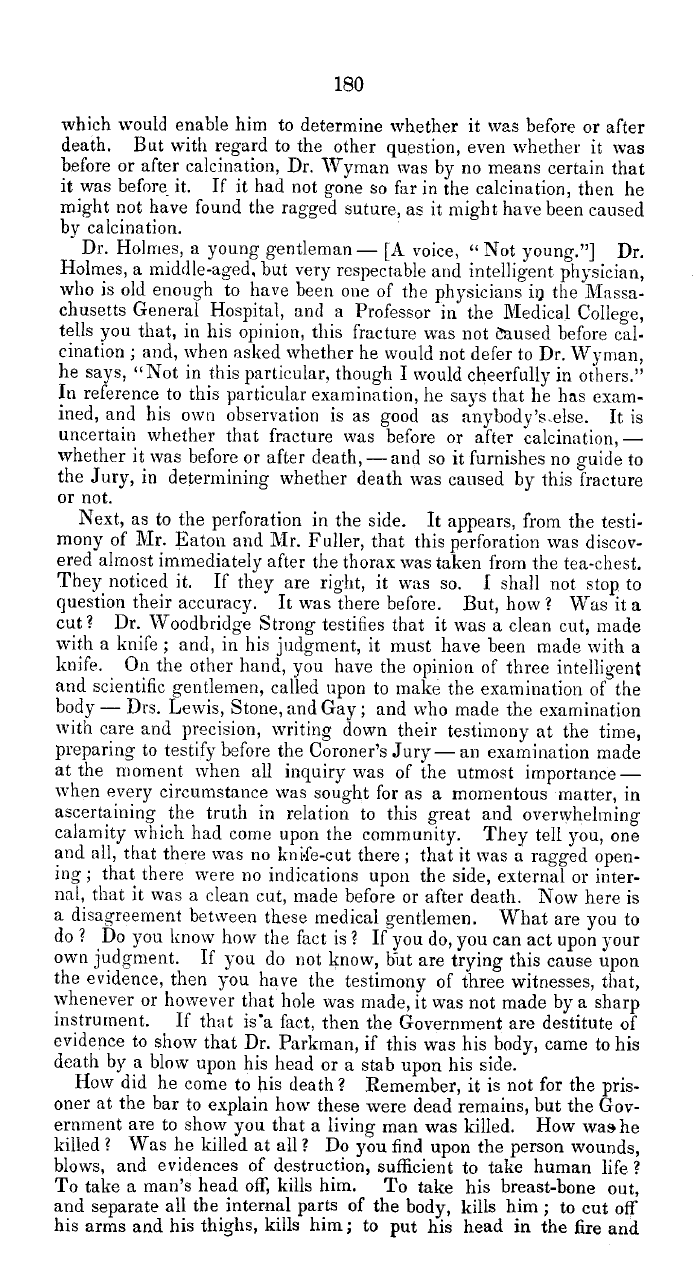|
180
which would enable him to determine whether it was before or after
death. But with regard to the other question, even whether it was
before or after calcination, Dr. Wyman was by no means certain that
it was before- it. If it had not gone so far in the calcination, then he
might not have found the ragged suture, as it might have been caused
by calcination.
- Dr. Holmes, a young gentleman - [A voice, °° Not young."] Dr.
Holmes, a middle-aged, but very respectable and intelligent physician,
who is old enough to have been one of the physicians ig the Massa-
chusetts General Hospital, and a Professor in the Medical College,
tells you that, in his opinion, this fracture was not maused before cal-
cination ; and, when asked whether he would not defer to Dr. Wyman,
he says, " Not in this particular, though I would cheerfully in others."
In reference to this particular examination, he says that he has exam-
ined, and his own observation is as good as anybody's, else. It is
uncertain whether that fracture was before or after calcination, -
whether it was before or after death,-and so it furnishes no guide to
the Jury, in determining whether death was caused by this fracture
or not.
Next, as to the perforation in the side. It appears, from the testi-
mony of Mr. Eaton and Mr. Fuller, that this perforation was discov-
ered almost immediately after the thorax was taken from the tea-chest.
They noticed it. If they are right, it was so. I shall not stop, to
question their accuracy. It was there before. But, how? Was it a
cut? Dr. Woodbridge Strong testifies that it was a clean cut, made
with a knife ; and, in his judgment, it must have been made with a
knife. On the other hand, you have the opinion of three intelligent
and scientific gentlemen, called upon to make the examination of the
body - Drs. Lewis, Stone, and Gay; and who made the examination
with care and precision, writing down their testimony at the time,
preparing to testify before the Coroner's Jury- an examination made
at the mornent when all inquiry was of the utmost importance-
when every circumstance was sought for as a momentous matter, in
ascertaining the truth in relation to this great and overwhelming
calamity which had come upon the community. They tell you, one
and all, that there was no knife-cut there ; that it was a ragged open-
ing ; that there were no indications upon the side, external or inter-
nat, that it was a clean cut, made before or after death. Now here is
a disagreement between these medical gentlemen. What are you to
do ? Do you know how the fact is ? If you do, you can act upon your
own judgment. If you do not know, but are trying this cause upon
the evidence, then you have the testimony of three witnesses, that,
whenever or however that hole was made, it was not made by a sharp
instrument. If that is'a fact, then the Government are destitute of
evidence to show that Dr. Parkman, if this was his body, came to his
death by a blow upon his head or a stab upon his side.
How did he come to his death? Remember, it is not for the pris-
oner at the bar to explain how these were dead remains, but the Gov-
ernment are to show you that a living man was killed. How was he
killed? Was he killed at all? Do you find upon the person wounds,
blows, and evidences of destruction, sufficient to take human life. ?
To take a man's head off, kills him. To take his breast-bone out,
and separate all the internal parts of the body, kills him ; to cut off
his arms and his thighs, kills him; to put his head in the fire and
|

